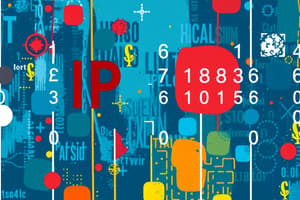Podcast
Questions and Answers
What is required for devices in the same network/subnet to communicate directly?
What is required for devices in the same network/subnet to communicate directly?
- They must have identical IP addresses.
- They must connect through the same default gateway.
- They must have different subnet masks.
- They must share the same network/subnet portion. (correct)
When PC1 is attempting to communicate with PC2, what determines whether it uses the MAC address of PC2 or the default gateway?
When PC1 is attempting to communicate with PC2, what determines whether it uses the MAC address of PC2 or the default gateway?
- Whether PC1 has permission to access PC2.
- Whether the IP address of PC2 is reachable over the internet.
- Whether PC2 is in the same network/subnet as PC1. (correct)
- Whether PC1 is connected to a Wi-Fi or Ethernet network.
What does PC1 compare to determine its network/subnet ID?
What does PC1 compare to determine its network/subnet ID?
- PC1's IP address and PC2's IP address in decimal.
- PC1's IP address and the DNS server.
- PC1's MAC address and the subnet mask.
- PC1's IP address and its subnet mask in binary. (correct)
In the binary comparison for subnet identification, what do the 1s in the subnet mask represent?
In the binary comparison for subnet identification, what do the 1s in the subnet mask represent?
What will happen if PC1 determines that 192.0.2.1 is not in its subnet based on the subnet comparison?
What will happen if PC1 determines that 192.0.2.1 is not in its subnet based on the subnet comparison?
What is a critical consequence of incorrect IPv4 addressing in a network?
What is a critical consequence of incorrect IPv4 addressing in a network?
Which component of an IPv4 address identifies the specific device on a network?
Which component of an IPv4 address identifies the specific device on a network?
What does the packet-forwarding process rely on for verifying routing entries?
What does the packet-forwarding process rely on for verifying routing entries?
Which DHCP configuration option ensures devices receive their IPv4 addressing dynamically?
Which DHCP configuration option ensures devices receive their IPv4 addressing dynamically?
Which method allows clients to automatically configure their IPv6 addresses without a DHCP server?
Which method allows clients to automatically configure their IPv6 addresses without a DHCP server?
What command would you use to display all IP-related parameters for a router interface?
What command would you use to display all IP-related parameters for a router interface?
In IPv4 addressing, what is the purpose of the network/subnet portion?
In IPv4 addressing, what is the purpose of the network/subnet portion?
Which of the following terms is associated with a mechanism to dynamically assign IP addresses?
Which of the following terms is associated with a mechanism to dynamically assign IP addresses?
What type of routes allows manual configuration of paths in both IPv4 and IPv6?
What type of routes allows manual configuration of paths in both IPv4 and IPv6?
What characterizes the structure of the routing table in relation to IPv4 addressing?
What characterizes the structure of the routing table in relation to IPv4 addressing?
Which command will help you identify IP address conflicts on a router configured as a DHCP server?
Which command will help you identify IP address conflicts on a router configured as a DHCP server?
Which type of address does a DHCP server mainly assign during the IP address allocation process?
Which type of address does a DHCP server mainly assign during the IP address allocation process?
What does the term SLAAC stand for in network configuration?
What does the term SLAAC stand for in network configuration?
In the context of IP routing, which of these is considered part of the control plane?
In the context of IP routing, which of these is considered part of the control plane?
What message type is typically sent to solicit router advertisements?
What message type is typically sent to solicit router advertisements?
Which command would display the IP addresses assigned by an IOS DHCP server and their lease information?
Which command would display the IP addresses assigned by an IOS DHCP server and their lease information?
What determines the network/subnet portion of an IP address in a device?
What determines the network/subnet portion of an IP address in a device?
If PC1 has a subnet mask of 255.255.255.240, what network/subnet ID does it determine?
If PC1 has a subnet mask of 255.255.255.240, what network/subnet ID does it determine?
What happens if PC1 incorrectly assumes PC2 is in a different subnet?
What happens if PC1 incorrectly assumes PC2 is in a different subnet?
How is the most interesting octet in a subnet mask defined?
How is the most interesting octet in a subnet mask defined?
What subnet mask will lead to PC1 mistakenly believing it is on a different network than PC2?
What subnet mask will lead to PC1 mistakenly believing it is on a different network than PC2?
In the context of IP addressing, what does the term 'default gateway' refer to?
In the context of IP addressing, what does the term 'default gateway' refer to?
What is the outcome of comparing the PC1's subnet ID with the web server's IP address?
What is the outcome of comparing the PC1's subnet ID with the web server's IP address?
What is the result of subtracting 192 from 256 in the context of determining IP addresses in a subnet?
What is the result of subtracting 192 from 256 in the context of determining IP addresses in a subnet?
What step does R1 take to determine how to reach the IP address 10.1.12.2?
What step does R1 take to determine how to reach the IP address 10.1.12.2?
What does R1 assume when it finds the longest match for the destination IP 10.1.3.1?
What does R1 assume when it finds the longest match for the destination IP 10.1.3.1?
How does R1 obtain the MAC address for the destination IP when it believes the network to be directly connected?
How does R1 obtain the MAC address for the destination IP when it believes the network to be directly connected?
What is the purpose of proxy ARP in a router's ARP cache?
What is the purpose of proxy ARP in a router's ARP cache?
What can be inferred about the ARP cache entries when proxy ARP is enabled on R1?
What can be inferred about the ARP cache entries when proxy ARP is enabled on R1?
What does the 'show ip interface' command signify regarding proxy ARP?
What does the 'show ip interface' command signify regarding proxy ARP?
What happens if proxy ARP is disabled on R1 with respect to ARP requests?
What happens if proxy ARP is disabled on R1 with respect to ARP requests?
What does R1's routing decision imply about data packets trying to reach IP addresses in the 10.1.3.0/24 subnet?
What does R1's routing decision imply about data packets trying to reach IP addresses in the 10.1.3.0/24 subnet?
Flashcards are hidden until you start studying
Study Notes
IPv4 Addressing
- An IPv4 address consists of a network/subnet portion and a host portion, essential for identifying devices in a network.
- Devices within the same subnet must share identical network/subnet portions to communicate directly.
- The communication process involves a DNS lookup for the target IP address, prompting devices to confirm subnet membership before direct communication.
Subnet Membership Determination
- Subnet membership is confirmed by comparing binary representations of IP addresses and subnet masks.
- Mismatches in subnet portions prompt communication through a default gateway instead of directly.
Issues with Incorrect Subnet Masks
- An incorrect subnet mask can cause connectivity issues, as seen when PC1 fails to recognize PC2 as part of the same subnet despite being connected.
- Understanding and verifying the correct subnet mask is crucial for ensuring proper IP addressing and connectivity.
Static Routes
- Static routes require manual configuration and enable routing of packets between different subnets.
- Routers rely on longest match algorithms to determine the most specific route for packet forwarding.
Proxy ARP
- Proxy ARP allows routers to respond to ARP requests with their MAC addresses if they have a route to the requested IP address, enabling communication across different subnets.
- Proxy ARP is enabled by default on routers, facilitating seamless connectivity in specific scenarios.
Troubleshooting
- Structured troubleshooting processes are essential for resolving reported problems related to IPv4 addressing and routing.
- Familiarization with commands like
show ip route,show ip interface, andshow ip dhcp bindingcan aid in troubleshooting.
Key Terms
- DHCP: Dynamic Host Configuration Protocol, automatically assigns IP addresses to devices.
- SLAAC: Stateless address autoconfiguration, enables IPv6 devices to self-configure IP addresses without a DHCP server.
- DORA Process: The four-step process (Discover, Offer, Request, Acknowledge) for DHCP operation.
- ARP: Address Resolution Protocol, maps IP addresses to MAC addresses.
- CIDR: Classless Inter-Domain Routing, notation for IP addressing (e.g., /24).
Command Reference
ipconfig: Displays IP address, subnet mask, and default gateway for a Windows PC.show ip interface: Displays various IP-related parameters for a router interface.show ip dhcp conflict: Identifies any IP address conflicts a DHCP server encounters.show ip dhcp binding: Displays IP addresses assigned by a DHCP server along with their MAC addresses and lease details.
Studying That Suits You
Use AI to generate personalized quizzes and flashcards to suit your learning preferences.




